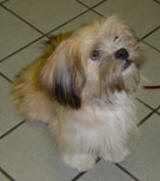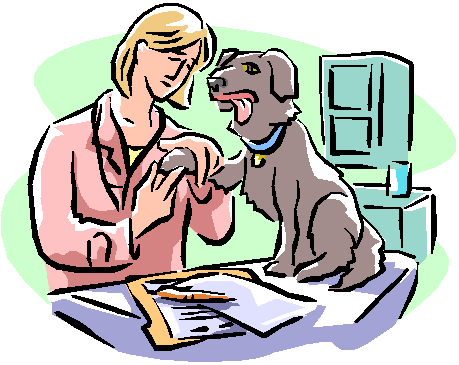 Some
dog and cat breeds are routinely
professionally groomed, while
others may never set foot in
a grooming parlor in their lives.
Even these pets will periodically
need bathing, and combing and
brushing should be done on a
regular program.
Some
dog and cat breeds are routinely
professionally groomed, while
others may never set foot in
a grooming parlor in their lives.
Even these pets will periodically
need bathing, and combing and
brushing should be done on a
regular program.
The
goal is to introduce all aspects
of grooming as early in the
pet's life as possible,
and to try to make it a positive
experience.
The
wrong lesson:
First, know what not to
do when you're introducing a
dog to grooming. Here are common
scenarios that teach puppies
the wrong lesson about being
groomed:
-
Squealing: The
first time he is brushed, the
puppy squeals. You stop brushing
him and start cuddling and comforting
him. The puppy has learned that
squealing stops brushing and
prompts petting.
-
Squirming:
The puppy squirms. You stop
grooming her, and she dashes
off for a romp—another
triumph for the pup.
-
Nipping:
The pup nips at the hand holding
the brush, and you stop brushing
him. The puppy has learned to
bite the groomer. Although he
has won in the short term, a
lifetime of muzzles, tranquilizers,
and restraints await.
-
Don't despair.
Most dogs and puppies will try
some of these maneuvers. However,
if you make it clear that such
conduct is not appreciated and
continue grooming, most dogs
will settle down.
|
The
first step in establishing
good grooming behavior is
teaching your dog to accept
handling on all parts of
his body. |
The
right things to do
Here are some ways to make grooming
a more positive experience:
 Massage:
The first step in establishing
good grooming behavior is teaching
your dog to accept handling
on all parts of his body. Many
dogs prefer that you don't touch
their feet; others don't want
their tails or rears handled.
Pick a time when you are both
relaxed, for instance when Fido
has settled down for a post dinner
snooze. Sit down next to him
and speak softly while massaging
his body all over. Encourage
him to lie quietly and enjoy
the process. Begin with the
top spots on Fido's "petting
hit parade," such as his
belly, ears, and rump. When
he is enjoying this, progress
to places that don't
make his "Top 10 list,"
like the tail, thighs, hocks,
toes, nails and pads. Praise
him for lying still and relaxing.
Massage:
The first step in establishing
good grooming behavior is teaching
your dog to accept handling
on all parts of his body. Many
dogs prefer that you don't touch
their feet; others don't want
their tails or rears handled.
Pick a time when you are both
relaxed, for instance when Fido
has settled down for a post dinner
snooze. Sit down next to him
and speak softly while massaging
his body all over. Encourage
him to lie quietly and enjoy
the process. Begin with the
top spots on Fido's "petting
hit parade," such as his
belly, ears, and rump. When
he is enjoying this, progress
to places that don't
make his "Top 10 list,"
like the tail, thighs, hocks,
toes, nails and pads. Praise
him for lying still and relaxing.
Repeat
this routine for a few minutes
every day until the pet is calm,
relaxed, and seeking attention.
The
brush: Once Fido has started
eagerly anticipating time with
his "personal masseuse,"
the time is ripe to introduce
the brush. Don't attempt any
serious grooming at this point.
The object is to get Fido used
to the feel of a brush and have
him link it to the pleasure
of massage. Perhaps most important
is to ALTERNATE the brush stroke,
with a hand stroke. If possible
do the entire process when the
pet is tired and relaxed.
Brush
for a few moments the first
time. Each succeeding day, intersperse
a little more brushing than
massaging. Make sure to brush
all parts of the pet's
body, not just the ones he likes
best. Praise him lavishly for
good behavior and maybe even
give a special treat at the
end of the session.
The
great escape:
Inevitably, he will decide that
he has something more important
to do than getting brushed.
It must be you, not the pet,
who determines when the grooming
session will end. You will know
that Fido is planning his escape
when you feel his body tense
up. Before he can make his move,
place your hand flat on his
neck, a few inches below his
ears and firmly say "STAY!"
Praise him when he relaxes.
Continue brushing for a few
more seconds before letting
Fido make his exit.
Complaints:
Growling or snapping will not
make for a good session. If
this occurs, it probably means
that you are going too quickly,
or that there is some distrust.
Begin a program of requiring
a SIT or DOWN before meals,
going out doorways, or giving
any attention. Slow down the
massage, and mix in some food
treats with the brushing.
Noisy
equipment: If
the sound of electrical equipment,
like clippers or dryers, frightens
your dog, wait until he is relaxed
and introduce him to such equipment
gradually. Turn the clippers
on at a distance where the noise
arouses interest but doesn't
frighten him. While the equipment
is running, feed him treats
and pet him until he relaxes.
Repeat this procedure for several
days until he is completely
confident, then gradually move
the equipment closer until he
accepts it at close range. Finally,
let him feel it on him body,
the same way you introduced
the brush to him.
Grooming
tips: Grooming
is a two-way street. Your dog
should behave for you, but you
owe it to her to make grooming
easier for her. Here are some
tips for producing a well-groomed
pet:
-
Always use a conditioning spray
before grooming. It smoothes
tangles and makes brushing more
comfortable.
- Brush all the way to the skin.
Brushing only the top of the
coat will leave the undercoat
matted and dirty.
- Ask your groomer or breeder
about the best methods and equipment
for handling your pet's coat.
- Dematting tools with sharp,
bladed teeth can easily injure
your pet. If your pet requires
dematting, take her to a groomer
who is trained in how to handle
such problems.
- It is kindest, if very matted,
to have the groomer clip her
coat very short – "a
buzz!"